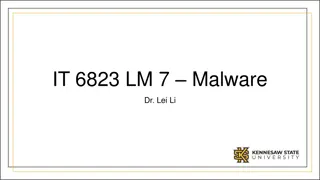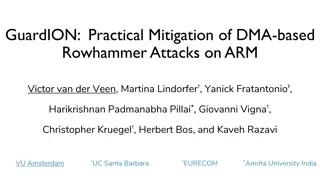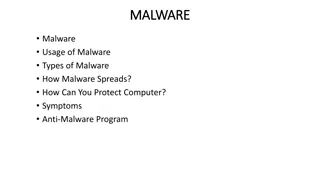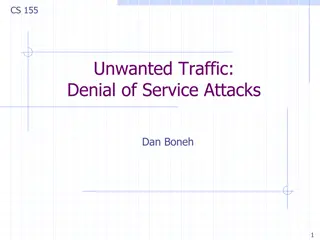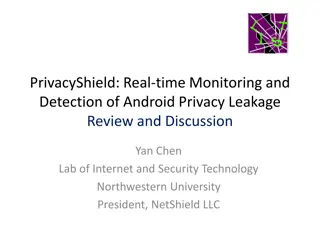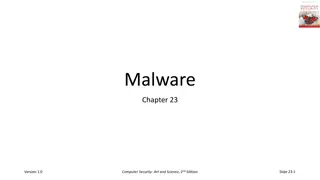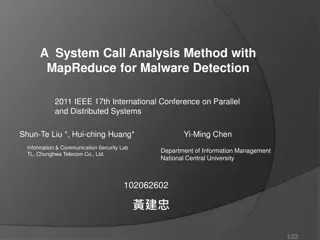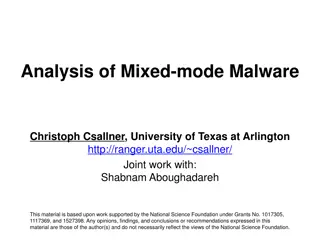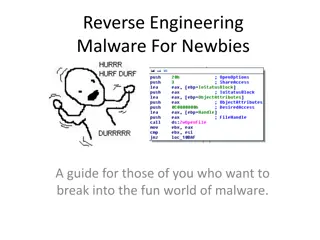Evaluating Android Anti-malware Against Transformation Attacks
This study evaluates the effectiveness of Android anti-malware solutions against transformation attacks, focusing on the resistance to various types of malware obfuscations. It explores different transformations such as repacking, trivial changes, and sophisticated obfuscation techniques. Ten popular anti-malware products were assessed using six malware samples, including DroidDream and FakePlayer. The research highlights the evolving nature of smartphone malware and the need for robust security measures in the Android ecosystem.
Download Presentation

Please find below an Image/Link to download the presentation.
The content on the website is provided AS IS for your information and personal use only. It may not be sold, licensed, or shared on other websites without obtaining consent from the author.If you encounter any issues during the download, it is possible that the publisher has removed the file from their server.
You are allowed to download the files provided on this website for personal or commercial use, subject to the condition that they are used lawfully. All files are the property of their respective owners.
The content on the website is provided AS IS for your information and personal use only. It may not be sold, licensed, or shared on other websites without obtaining consent from the author.
E N D
Presentation Transcript
DroidChameleon: Evaluating Android Anti-malware against Transformation Attacks Vaibhav Rastogi, Yan Chen, and Xuxian Jiang Lab for Internet and Security Technology, Northwestern University North Carolina State University 1
Android Dominance Smartphone sales already exceed PC sales Android world-wide market share ~ 70% Android market share in US ~50% (Credit: Kantar Worldpanel ComTech) 2
Introduction Android malware a real concern Many Anti-malware offerings for Android Many are very popular Source: http://play.google.com/ | retrieved: 4/29/2013 3
Objective What is the resistance of Android anti-malware against malware obfuscations? Smartphone malware is evolving Encrypted exploits, encrypted C&C information, obfuscated class names, Polymorphic attacks already seen in the wild Technique: transform known malware 4
Transformations: Three Types No code-level changes or changes to AndroidManifest Trivial Detectable by Static Analysis - DSA Do not thwart detection by static analysis completely Not detectable by Static Analysis NSA Capable of thwarting all static analysis based detection 5
Trivial Transformations Repacking Unzip, rezip, re-sign Changes signing key, checksum of whole app package Reassembling Disassemble bytecode, AndroidManifest, and resources and reassemble again Changes individual files 6
DSA Transformations Changing package name Identifier renaming Data encryption Encrypting payloads and native exploits Call indirections 7
Evaluation 10 Anti-malware products evaluated AVG, Symantec, Lookout, ESET, Dr. Web, Kaspersky, Trend Micro, ESTSoft (ALYac), Zoner, Webroot Mostly million-figure installs; > 10M for three All fully functional 6 Malware samples used DroidDream, Geinimi, FakePlayer, BgServ, BaseBridge, Plankton Last done in February 2013. 8
DroidDream Example AVG Symantec Lookout ESET Dr. Web Repack x Reassemble x Rename package x x Encrypt Exploit (EE) x Rename identifiers (RI) x x Encrypt Data (ED) x Call Indirection (CI) x RI+EE x x x EE+ED x EE+Rename Files x EE+CI x x 9
DroidDream Example Kasp. Trend M. ESTSoft Zoner Webroot Repack Reassemble x Rename package x x Encrypt Exploit (EE) x Rename identifiers (RI) x x Encrypt Data (ED) x Call Indirection (CI) x RI+EE x x EE+ED x x EE+Rename Files x x EE+CI x 10
Findings All the studied tools found vulnerable to common transformations At least 43% signatures are not based on code-level artifacts 90% signatures do not require static analysis of Bytecode. Only one tool (Dr. Web) found to be using static analysis 11
Signature Evolution Study over one year (Feb 2012 Feb 2013) Key finding: Anti-malware tools have evolved towards content-based signatures Last year 45% of signatures were evaded by trivial transformations compared to 16% this year Content-based signatures are still not sufficient 12
Takeaways Anti-malware vendors Google and device manufacturers Need to provide better platform support for anti-malware Need to have semantics- based detection 13
Impact The focus of a Dark Reading article on April 29 Contacted by Lookout Director of Security Engineering regarding transformation samples and tools on May 2nd Contacted by McAfee Lab and TechNewsDaily this week 14
Conclusion Developed a systematic framework for transforming malware Evaluated latest popular Android anti-malware products All products vulnerable to malware transformations 16
Thank You! http://list.cs.northwestern.edu/mobile 17
BACKUP 18
Solutions Content-based Signatures are not sufficient Analyze semantics of malware Dynamic behavioral monitoring can help Need platform support for that 19
NSA Transformations Reflection Obfuscate method calls Subsequent encryption of method names can defeat all kinds of static analysis Bytecode encryption Encrypt the malicious bytecode load at runtime using user-defined class loader 22





